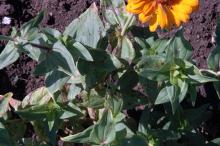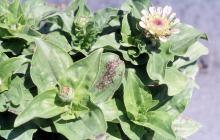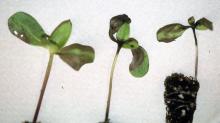See:
Cause The fungus Alternaria zinniae has been reported on zinnia from Oregon and found many times on samples sent to the OSU Plant Clinic. The fungus overwinters in plant debris in soil or through contaminated seed. The fungus may persist in seeds for up to 7 years but for only 2 years in plant debris. Generally, weather or irrigation that keeps leaves wet for extended periods favors the disease, as does low nitrogen fertility. Free moisture is required for infection.
All Zinnia elegans selections are moderately to highly susceptible while Z. angustifolia is highly resistant.
Symptoms Small, circular, reddish-brown spots with grayish-white centers increase to irregular, large, brown dry areas. Leaves become brown and desiccated. Similar spots are on stems and may girdle the stem with dieback of the portions distal to that lesion. Dark brown-to-black cankers with sunken centers may also appear near the soil line. On flowers, small brown spots can enlarge to include the whole petal. Sporulation may be profuse and petals darken and wither. Damping-off of seedlings can also occur. May be confused with bacterial leaf spot, which has very similar symptoms.
Cultural control
- Start with pathogen-free seed. Seed can be treated with hot water at 125°F for 20 minutes but will also reduce germination. Seeds can also be treated with 1% to 2.5% lactic acid for 30 min or 12% peroxide for 20 min.
- Plant resistant cultivars or species such as Z. angustifolia.
- Irrigate so that leaves are not wet for extended periods.
- Increased plant spacing will help air circulation and shorted leaf-wetness periods.
- Remove and destroy plant debris during and at the end of the growing season.
- Discard contaminated plug trays or packs.
- Rotate plantings to different beds each year.
- Use a balanced fertilizer, maintain EC from 1.25 to 1.5 and a pH of 5.8 to 6. Note that zinnias tend to naturally increase the growing media pH.
Chemical control Start with copper-based products (Group M1 fungicides) if you are not sure if symptoms were due to fungal or bacterial infection.
- Affirm WDG at 0.25 to 0.5 lb/100 gal water. Group 19 fungicide. 4-hr reentry.
- Avelyo at 3 to 5 fl oz/100 gal water. Group 3 fungicide. 12-hr reentry.
- Badge X2 at 1.5 to 2 lb/A. Group M1 fungicide. 24-hr greenhouse reentry. O
- Banner MAXX at 5 to 8 fl oz/100 gal water. Not for use in the greenhouse. Group 3 fungicide. 12-hr reentry.
- Bonide Fung-onil Multi-purpose Fungicide at 2.25 teaspoons/gal water. Group M5 fungicide. H
- Broadform at 4 to 8 fl oz/100 gal water. Group 7 + 11 fungicide. 12-hr reentry.
- Chipco 26019 FLO at 1 to 2.5 quarts /100 gal water. Group 2 fungicide. 12-hr reentry.
- Compass 50 WDG at 2 to 4 oz/100 gal water. Do not use organosilicate additives. Group 11 fungicide. 12-hr reentry.
- CuPRO 5000 at 1.5 to 2 lb/A. Group M1 fungicide. 48-hr reentry.
- Daconil Weather Stik at 1.38 pints/100 gal water. Group M5 fungicide. 12-hr reentry.
- Disarm 480 SC at 1 to 4 fl oz/100 gal water. Group 11 fungicide. 12-hr reentry.
- Eagle 20 EW at 6 to 12 fl oz/100 gal water. Group 3 fungicide. 24-hr reentry.
- Fame SC at 1 to 4 fl oz/100 gal water. Group 11 fungicide. 12-hr reentry.
- Heritage at 1 to 8 oz/100 gal water plus a non-silicone-based wetter sticker. Group 11 fungicide. 4-hr reentry.
- Mancozeb-based products. Group M3 fungicides. 24-hr reentry.
- Fore 80 WP at 1.5 lb/100 gal water plus a spreader-sticker.
- Protect DF at 1 to 2 lb/100 gal water plus 2 to 4 oz spreader-sticker.
- Medallion WDG at 1 to 2 oz/100 gal water. Using with oils or adjuvants may damage plant. Group 12 fungicide. 12-hr reentry.
- Orkestra at 4 to 6 fl oz/100 gal water. Group 7 + 11 fungicide. 12-hr reentry.
- Pageant at 4 to 8 oz/100 gal water. Do not use with organosilicone-based adjuvants. Group 7 + 11 fungicide. 12-hr reentry.
- Palladium at 4 to 6 oz/100 gal water. Avoid excessive runoff to small plants, which may result in stunting and/or chlorosis. Group 9 + 12 fungicide. 12-hr reentry.
- Spectro 90 WDG at 1 to 2 lb/100 gal water. Group 1 + M5 fungicide. 12-hr reentry.
- Spirato GHN at 1 to 2 fl oz/100 gal water. Use with oils or adjuvants may cause plant damage. Group 12 fungicide. 12-hr reentry.
- Terraguard SC at 4 to 8 fl oz/100 gal water. Group 3 fungicide. 12-hr reentry.
- Trinity at 4 to 12 fl oz/100 gal water. Group 3 fungicide. 12-hr reentry.
Biological control
- Stargus (Bacillus amyloliquefaciens strain F727) at 2 to 4 quarts/A plus a nonionic surfactant. Group BM02 fungicide. 4-hr reentry. O
References Dimock, A.W. and Osborn, J.H. 1943. An Alternaria disease of zinnia. Phytopathology 33:372-381.
Szopinska, D. 2017. Diseases of Zinnia. In McGovern, R.J., and Elmer, W.H. (eds.) Handbook of Florists' Crops Diseases. Springer Int.




